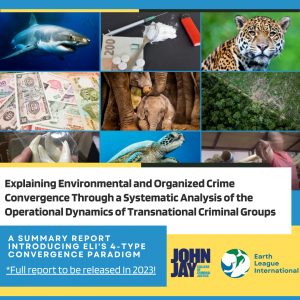Explaining Environmental and Organized Crime Convergence Through a Systematic Analysis of the Operational Dynamics of Transnational Criminal Groups: a new research paradigm by ELI
Los Angeles, November 12, 2022 / Earth League International (ELI) has partnered with John Jay College of Criminal Justice to produce a ground-breaking summary report on Environmental Crime Convergence.
As one of the world’s most destructive, fast-growing, and lucrative transnational organized crimes (TOC), environmental crimes, such as wildlife trafficking, illegal logging, and illegal fishing, rarely occur in isolation at the highest levels. Environmental crime is a cross-cutting transnational criminal activity, that occurs in convergence with other serious crimes, including money laundering, corruption, human trafficking, and as well as threatens peace and national security.

The foundation of this summary report is built upon the fieldwork and intelligence analysis of ELI’s investigators and crime analysts, who have gathered first-hand evidence of Environmental Crime Convergence directly from some of the world’s most notorious environmental criminals and their networks. This report develops and presents ELI’s path-breaking convergence paradigm to show exactly how convergence has integrated wildlife and environmental crime into the heart of global economic and political structures
Drawing on years of investigative fieldwork in the Americas, Europe, Africa, and Asia, over two dozen case studies have emerged from ELI’s work as primary sources of data. This report highlights five (5) case studies of the transnational criminal networks identified by ELI that illustrate the convergence of environmental and wildlife crime with other serious crimes. We present the following criminal networks: Networks M2 and M3 based in Mexico; SA4 based in Bolivia; SA1 based in Suriname; and SA8 based in Peru. They all operate globally, including in the U.S. and China.
These cases are analyzed using ELI’s path-breaking Environmental Crime Convergence Paradigm, in which ELI has defined, instituted, and analyzed Four Convergence Typologies:
- Multiple Species Convergence, which refers to the trafficking of multiple species at the same time (e.g. rhino horn, ivory, pangolin, jaguar, shark fin, seafood).
- Multiple Environmental Crime Convergence, which involves the same traffickers or networks engaging in wildlife crime, plus the trafficking of other natural resources, such as illegal logging, illegal fishing, and illegal mining.
- Serious Crime Convergence, which refers to the same traffickers or networks engaging in other serious crimes, such as money laundering, human smuggling, and drug trafficking.
- Transnational Networks Convergence, which describes the overlap of transnational organized criminal networks and their activities. Network convergence is multileveled, as these criminal networks have intentionally created a variety of regional, interregional, and transnational points of connection to strengthen their criminal activities.
Through these case studies and ELI’s Environmental Crime Convergence Paradigm, we aim to address critical information gaps regarding environmental crime convergence and provide an empirical understanding of its scope and degree.
The report also includes a systematic review of the literature on this topic done by John Jay College of Criminal Justice, which revealed the limited number of studies that generated convergence typologies related to environmental crime. An overwhelming majority of these studies (70%) relied on secondary data, literature review, analysis, and review of reports generated from governments and NGOs, as well as other grey literature.
Where do we go from here?
A focus on crime convergence widens the opportunities to detect and capture criminal leaders. Environmental crimes are extremely difficult to prosecute, and among the small minority that are, sanctions are rarely strong enough to be deterrents. But, as in the case of Al Capone, evidence of other crimes – from money laundering to assassination – are more promising ways to catch them.
Such proactive efforts to broaden systematic investigations and intelligence analysis will increase the likelihood of identifying and disrupting criminal networks. As environmental crime is increasingly prioritized by efforts such as the U.S. National Security Strategy, this approach will allow for the diffusion of benefits across regional and international actions.
This report also supports international organizations’ current attempts at developing a draft Protocol under UNTOC that proposes to criminalize the intentional illicit trafficking of wild fauna and flora specimens. Specifically, this report provides support for this reform, which should (a) incorporate provisions on the convergence of wildlife crime and other serious crimes; (b) create the framework for mutual legal cooperation between international partners; and (c) offer definitional precision to key legal terms such as “trafficking”, “wildlife organized crime”, and “convergence.”
Download here the Environmental Crime Convergence Summary Report – Nov 2022
The report linked on this page is a summary report, with the full report to be released in June 2023.


